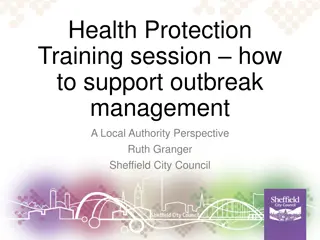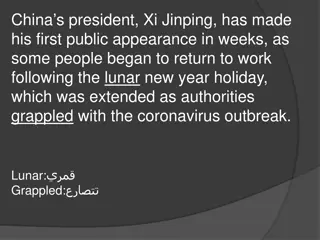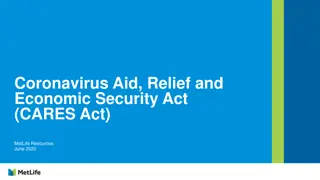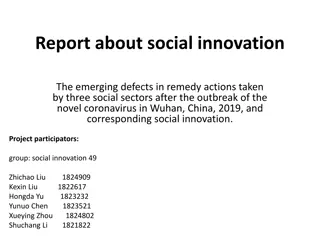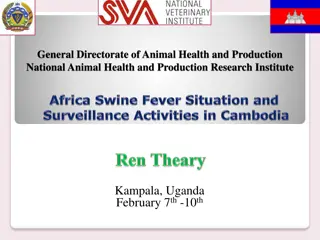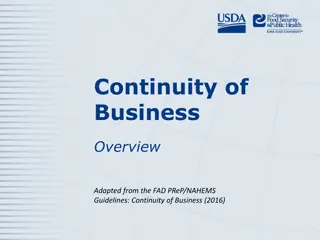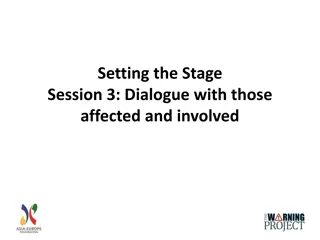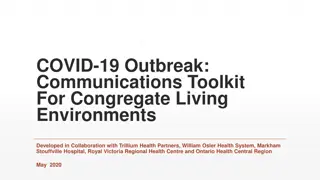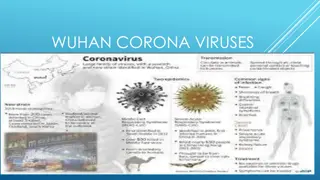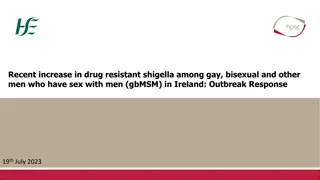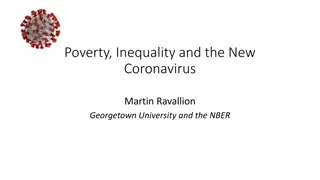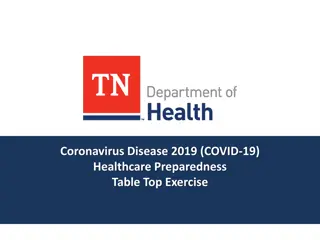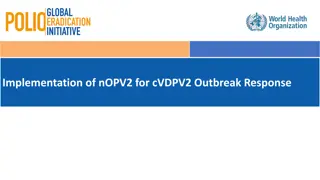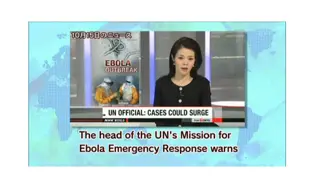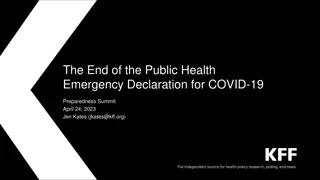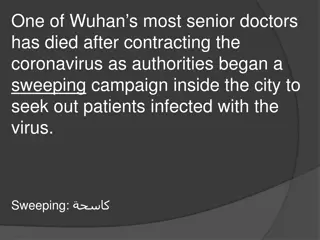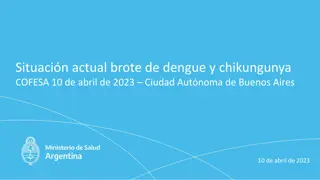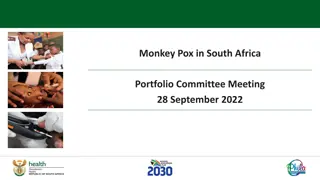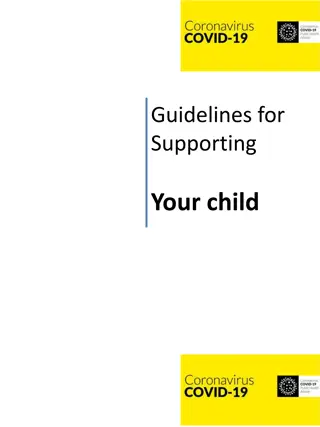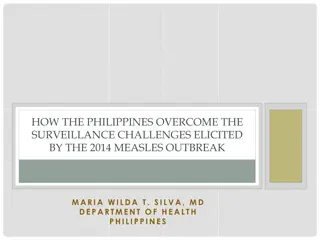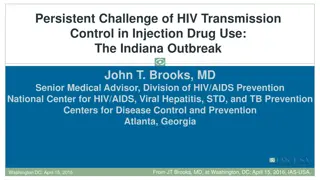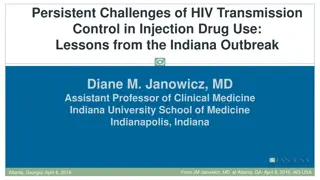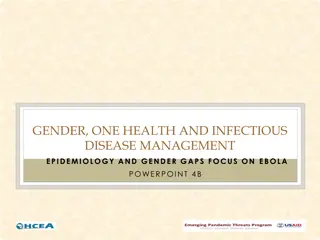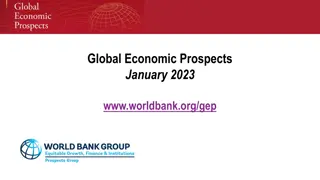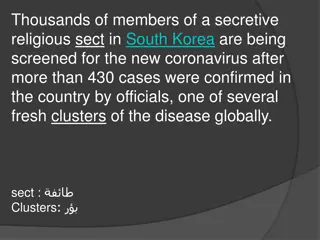Global Update on Novel Coronavirus Outbreak - January 2020
The evolving situation of the 2019-nCoV outbreak, with updates on confirmed cases, deaths, and affected countries. As of January 30, 2020, there are 7,818 laboratory-confirmed cases globally, with the majority in China. The outbreak has spread to several countries, prompting health emergencies programs and heightened surveillance worldwide.
Download Presentation

Please find below an Image/Link to download the presentation.
The content on the website is provided AS IS for your information and personal use only. It may not be sold, licensed, or shared on other websites without obtaining consent from the author. Download presentation by click this link. If you encounter any issues during the download, it is possible that the publisher has removed the file from their server.
E N D
Presentation Transcript
Member States briefing on the novel coronavirus 2019-nCoV 30 January 2020 HEALTH EMERGENCIES programme
Evolution of the 2019-nCoV outbreak (31 December 2019 - 30 January 2020) Dec 30, 2019 Cluster of cases of pneumonia of unknown origin reported to China National Health Commission Jan 29, 2020 First confirmed cases in UAE and Finland Jan 28, 2020 First confirmed Jan 11, 2020 First fatal case in China Jan 7, 2020 Novel coronavirus Jan 30, 2020 Jan 23, 2020 First confirmed Jan 19, 2020 First confirmed case in Germany isolated 2nd Emergency Committee case in Jan 13, 2020 First confirmed case in Nepal case in Korea Jan 26, 2020 First confirmed case in Canada Singapore 1st Member States briefing Jan 8, 2020 First confirmed Jan 14, 2020 First confirmed case in Japan Jan 25, 2020 First confirmed cases in Australia and Malaysia Jan 22-23, 2020 1st Emergency Committee case in Thailand Jan 20, 2020 Jan 27, 2020 First confirmed cases in Cambodia and Sri Lanka Jan 1, 2020 Huanan Seafood Wholesale market closed Infection in health-care workers caring for 2019- Jan 12, 2020 nCoV Patients Named as 2019-nCoV; Whole genome sequence shared with WHO Jan 24, 2020 First confirmed cases in France and Vietnam WHO Director General in China First confirmed cases in USA and South Korea China confirms human to human transmission HEALTH EMERGENCIES programme
Current Situation (As of 30 Jan, 10.30AM Geneva Time) Globally 7,818 laboratory confirmed cases of 2019-nCoV infection have been reported In China 7,736 confirmed cases in China from 31 provincial level administrative units, including Hong Kong SAR (10), Macao SAR (7), and Taipei Municipality (8) 1,370 severe cases 170 deaths (162 in Hubei Province, 2 in Henan and 1 each in Hainan, Hebei, Heilongjiang, Beijing, Shanghai and Sichuan) 12,167 suspected cases reported from Chinese provinces, regions and cities 81,947/88,693 contacts under follow-up Outside China 82 cases from 18 countries Thailand (14), Singapore (10), Japan (11), Australia (7), Malaysia (7), USA (5), France (5), Germany (4), Republic of Korea (4), United Arab Emirates (4), Canada (3), Viet Nam (2), Cambodia (1), Finland (1), Nepal (1), Sri Lanka (1), India (1), Philippines (1) 75 cases have been reported outside China with travel history to Wuhan City or China except 7 cases. Viet Nam (1), Japan (2), Germany (4) are close contact of confirmed case of 2019-nCoV or Chinese tourists of Wuhan. HEALTH EMERGENCIES programme
Replace with sit rep map HEALTH EMERGENCIES programme
Epidemic curve of confirmed cases of 2019-nCoV in China by date of reporting: data as of 30 Jan (source National Health Commission of China) 5 HEALTH EMERGENCIES programme
Cases outside China by date of illness onset Data reported from 18 countries 6 HEALTH EMERGENCIES programme
What do we know about transmission? Human-to-human transmission is occurring Close contacts, including family members and health care workers Ongoing transmission in China Hubei Province, transmission in other cities Human to human transmission reported outside of China (Vietnam, Japan, Germany) Amplifying events in health care and other settings potentially important No animal source yet identified 7 HEALTH EMERGENCIES programme
What do we know about the severity of disease? Respiratory symptoms reported, which range in severity from mild to pneumonia and death Globally, 18% of patients severe and 2% have died Disease among exported cases have not been severe Underlying conditions and advanced age reported for many of the fatal cases Further evaluation needed to better understand clinical spectrum of disease This outbreak can have serious public health consequences and a heavy impact on health care systems 8 HEALTH EMERGENCIES programme
WHO Risk Assessment reviewed as of 29 Jan Potential impact to human health Can causes severe disease and fatalities Severity is not fully understood Transmission from asymptomatic cases Likelihood of spread Ongoing human-to-human transmission Confirmed identified in 31 provincial level administrative areas (10 with >100 cases) Majority of cases exported outside China have been epidemiologically linked to Wuhan Human-to-human transmission documented in other countries Source of outbreak remains unknown Disaggregated data is needed to better understand the epidemiology Likelihood of insufficient control capacities China has implemented major control measures Currently affected countries have strong public health systems Some countries may be less prepared to manage cases 9 HEALTH EMERGENCIES programme
Priorities for stopping transmission and mitigating the impact of 2019-nCoV globally Limit human-to-human transmission Reduce secondary infections amongst close contacts and health care workers Prevent transmission amplification events and super spreading events Prevent further international spread Identify, isolate and care for patients early Equip countries to detect, isolate and care for infected patients Provide optimized care Address critical unknowns Identify animal source(s) and limit exposure Clinical severity, extent of transmission and infection, treatment options, diagnostics, therapeutics and vaccines Communicate critical risk and event information to all communities & countering misinformation Minimize social and economic impact through multisectoral partnerships 10 HEALTH EMERGENCIES programme
Global collaboration and coordination Priorities: Working with Political, Strategic, Technical and Operational Stakeholders, partners, and networks to leverage global capacity for preparedness and response. Working with Chinese scientists, and public health experts and global networks. Integration and coordination at country, regional, and global levels, for preparedness and Response. Activating expert networks to support the sharing of knowledge and development Building on existing strategies, partners, and networks, including: UN system wide coordination (Executive Group, Deputies, IASC) Global Outbreak Alert and Response Network (GOARN), collaborating centres, laboratories, and technical networks; Global Health Cluster and Country Health Clusters; Emergency Medical Teams WHO/FAO/OiE One Health Research and Development - R&D Blueprint Pandemic Supply Chain Network EOC network HEALTH EMERGENCIES programme
Global research & innovation 3 3 1 1 2 2 Common platforms, standardized processes, protocols and tools, as well as for sharing specimens, data and information Enhanced global coordinationof research A high-level discussion which enables consensus on strategic directions, nurtures scientific collaborations and, supports optimal and rapid research, without duplication of efforts. Robust/transparent priority setting process Fast track and scale up research, development and ethical and equitable access to most promising Txs, Vxs, Dxs and other MCMs To facilitate state of the art, multidisciplinary and collaborative research R&D Blueprint Global Coordination Mechanism. Landscape of Vaccines, Therapeutics and Diagnostics, Mabs, cross- protection Master protocol for trials for Vx and Txs Platform for clinical data collection MTA framework Ethical guidance Regulatory research Liability and compensation M&E Collaboration agreements. Formal and ad hoc expert groups. Prioritization of most promising Bilateral interactions with research institutions and Member States. Bilateral interactions with developers and funders
Need for global surveillance to advance knowledge Member States are encouraged to report confirmed cases within 24hrs and rapidly share epidemiological information with WHO: https://www.who.int/publications-detail/global-surveillance-for-human- infection-with-novel-coronavirus-(2019-ncov) How fast is 2019-nCoV spreading to unaffected areas? Where are cases exported from and to? What types of exposures are reported by travelers to affected areas? Are individuals symptomatic before travel and potentially detectable through exit screening? Is there person-to-person transmission occurring in newly affected countries? What is the clinical presentation of illness among travelers? 13 HEALTH EMERGENCIES programme
WHO technical guidance developed for all countries 1.Surveillance recommendations and case definitions 2.Laboratory testing for suspected human cases 3.Clinical management of severe acute respiratory infection 4.Infection prevention and control, protection of health care workers, prevention of transmission in health care settings 5.Home care for patients 6.Risk communication and community engagement 7.Country readiness checklist for preparedness and response 8.Disease commodity package for supplies necessary 9. Recommendations to reduce risk of transmission from animals to humans 10. Advice on the use of masks in the community, during home care and in health care settings https://www.who.int/health-topics/coronavirus 14 HEALTH EMERGENCIES programme
Travel advice and travel measures Updated WHO advice for international traffic on 27 January International travelers: practice usual precautions for prevention of respiratory disease transmission seek medical care if symptomatic International traffic: no restrictions recommended Exit screening in countries or areas with ongoing transmission (currently People s Republic of China) Entry screening in countries/areas without transmission of the novel coronavirus 2019-nCoV (although usually not cost-effective or cost-beneficial, in this outbreak majority of exported cases detected through entry screening) WHO monitors travel measures: 32 countries conducting entry screening 16 countries implementing restrictions during the last 8 days (media signals) 5 countries conducting evacuation of nationals from Wuhan, China HEALTH EMERGENCIES programme


